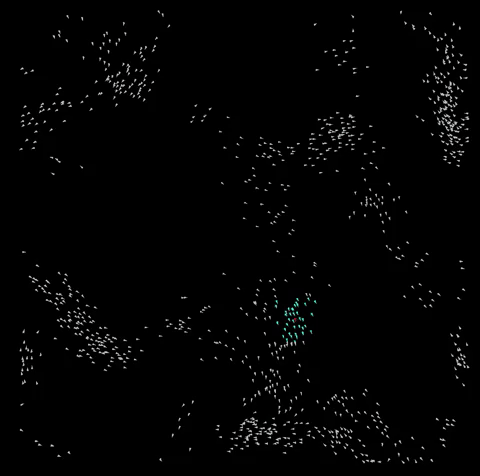- ➤ 📝 About The Project
- ➤ 🚀 Dependencies
- ➤ 🔨 Usage
- ➤ 💾 Key Project File Description
- ➤ ☕ Buy me a coffee
- ➤ 📜 Credits
- ➤ License
This project is an interactive 3D-rendered flock simulation inspired by the pioneering work of Craig Reynolds in his 1987 paper. The project brings to life the fascinating dynamics of flock behaviour with over 1000 individual Boids that closely follow the principles outlined in Reynolds' paper. The heart of this simulation lies in implementing three crucial rules: Alignment, Separation, and Cohesion.
Alignment: Each Boid in the simulation attempts to align its velocity with its neighbouring Boids. This rule creates the illusion of birds flying in the same general direction, maintaining a sense of unity within the flock.
Separation: Boids actively avoid colliding with their peers by calculating the direction towards other Boids and applying the opposite direction to their velocity. This behaviour results in the characteristic avoidance of collisions. It is fundamental in creating the appearance of individual Boids manoeuvring within the flock.
Cohesion: To mimic the natural tendency of birds sticking together, Boids are drawn towards the average position of their nearby companions. This cohesion rule ensures the flock remains relatively tightly knit and exhibits the graceful and cohesive movement observed in real-life bird flocks.
To enhance the performance of this simulation, I use a quad-tree data structure. Quad-trees facilitate efficient spatial partitioning of the Boids within the 3D world by recursively dividing the simulation space into smaller quadrants, with each quadrant containing a subset of Boids. This partitioning significantly improves the computational efficiency of the simulation, allowing it to run smoothly even when dealing with a large number of Boids. It helps each Boid effectively search for nearby Boids and apply the three principles in O(logn) time, meaning the simulation runs in O(nlogn) where n is the number of boids, contributing to the overall realism and smoothness of the flocking behaviour.
You can experience this mesmerizing 3D flock simulation at boids.theo-moore-calters.online. It beautifully captures the essence of bird-like flocking behaviour, demonstrating the elegance and simplicity of the principles put forth by Craig Reynolds in his iconic Boids paper.
The project is built using Vite and implemented in JavaScript. For the visual representation of the simulation, this project leverages the Three.js library.
The easiest way to play with the simulation is through the website. Users can rotate the world by clicking and dragging with their mouse. Users can also play with the principles by toggling them:
- Press
Sto toggle the seperation principle (boids will stop actively avoiding collision with each other) - Press
Cto toggle the cohesion principle (boids will stop actively clustering) - Press
Ato toggle the allignment principle
Also:
- Press
Mto toggle boid movement
Users can also quickly setup a local Vite App and git clone if they wish to play with the code. Something like:
git clone https://github.com/i1Cps/boids.git
cd boids/code
npm i
npm run dev
- The
main.jsfile initializes the 3D flock simulation with Boids. It runs the principles of alignment, cohesion, and separation on each boid every frame. Key functionalities include creating a scene, camera, and renderer, handling user input for enabling/disabling principles and boid movement, and updating the simulation's state. The code also manages the insertion of Boids into the Quad-tree. - The
boidAgent.jsfile represents individual boids in a 3D flock simulation. Each boid's behaviour is governed by principles of alignment, cohesion, and separation. The class handles boid movement, rotation, and interaction with neighbouring Boids using quad-tree spatial partitioning for efficient performance. - The
quadTree.jsfile defines a spatial data structure for efficient region-based querying of objects. It subdivides a given area into quadrants and organises objects within these quadrants. Key functions include insertion, finding objects within a specified range, and dividing the area into smaller quadrants when needed. Has complexity O(nlogn), read more here. - The
keyBoardInputs.jsfile is a simple logger for keyboard inputs.
Whether you use this project, have learned something from it, or just like it, please consider supporting it by buying me a coffee, so I can dedicate more time on open-source projects like this (҂⌣̀_⌣́)
Theo Moore-Calters
Licensed under MIT.








